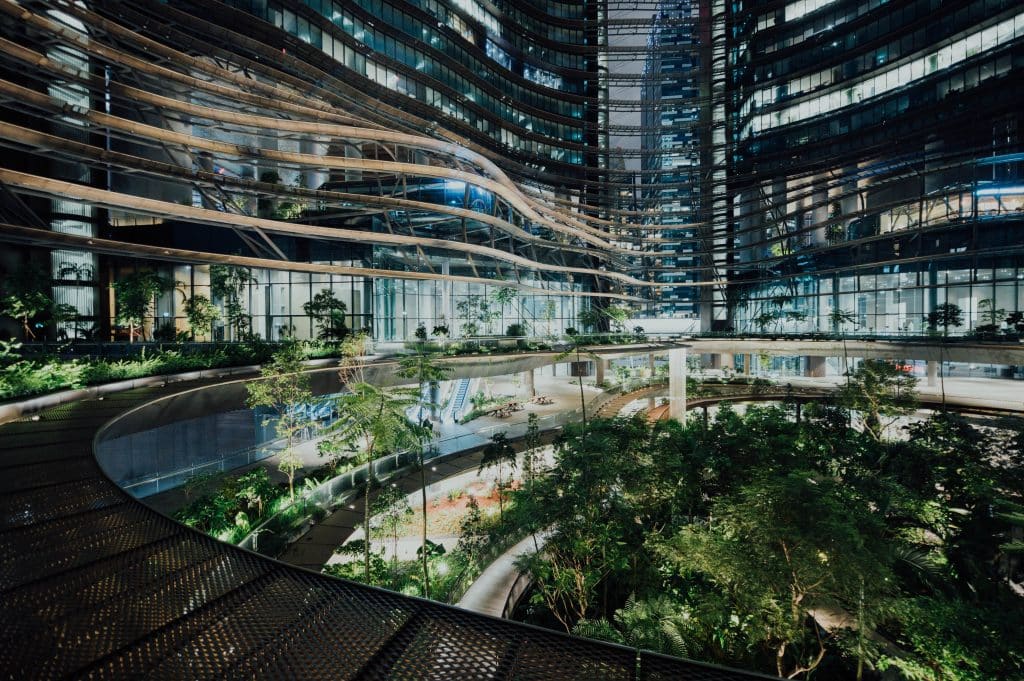As we move deeper into 2025, sustainable architecture trends are no longer niche experiments—they’re global imperatives. Climate change, urbanization, and population growth are pushing architects, engineers, and policymakers to rethink how we design and construct our built environment. From regenerative design and biomaterials to AI-driven planning and resilient urban infrastructure, the future of architecture is unfolding before our eyes.
This article explores the most important shifts, backed by real-world examples and expert insights, to give you a clear picture of where sustainable construction is heading in 2025.

1. Regenerative & Circular Design Become the New Standard
For years, “sustainability” in architecture meant reducing environmental damage. But now, a new paradigm—regenerative design—is emerging. Instead of simply minimizing harm, regenerative projects actively restore ecosystems, improve biodiversity, and generate net-positive benefits.
Take Singapore’s Labrador Tower, designed as an ultra-low-energy skyscraper integrating green façades, rainwater harvesting, and on-site energy generation. Similarly, Hong Kong’s I·PARK1 demonstrates how a development can produce energy from waste while maintaining biodiversity corridors that support local flora and fauna (Business Insider 2025). These projects illustrate that architecture can be a regenerative force, not just a neutral one.
Meanwhile, circular design practices—reusing materials, retrofitting instead of demolishing, and designing buildings for deconstruction—are gaining traction. Instead of seeing demolition waste as inevitable, architects are considering how to design for future reuse. According to the Financial Times (2025), adaptive reuse reduces embodied carbon by up to 60% compared with new construction, making it a crucial component of climate-conscious building strategies.
2. Biomaterials & Low-Carbon Materials Gain Momentum
Another major development in 2025 is the growing adoption of biomaterials. These are natural, biodegradable, and low-carbon alternatives to traditional construction inputs such as concrete and steel.
- Cork, hemp, and straw are seeing renewed interest as insulation and wall materials. The award-winning Cork House in the UK, for instance, shows how bio-based materials can deliver comfort, durability, and aesthetics (Wallpaper 2025).
- Timber skyscrapers, often called “plyscrapers,” are becoming more common. Cross-laminated timber (CLT) allows tall structures to be built with significantly lower emissions than steel or concrete.
In Australia, researchers are experimenting with algae bricks and oyster-shell composites—marine-based solutions that not only reduce waste but also lock carbon into long-lasting structures (The Guardian 2025). Though regulatory hurdles remain, these innovations point to an exciting future where buildings are not only sustainable but actively climate-positive.
This is especially relevant given the environmental cost of concrete, which accounts for roughly 8% of global carbon emissions (FT 2025). Materials such as bamboo, rammed earth, and stone are being revisited not as old-fashioned relics but as viable, sustainable options.
3. The Rise of Smart, Resilient, and AI-Driven Architecture
AI and Predictive Design
Artificial intelligence is transforming architecture by optimizing energy models, layouts, and material use. Advanced software can now simulate how buildings will perform in terms of energy efficiency, lighting, and occupant comfort before a single brick is laid. Hoefer Welker (2025) notes that digital twins—virtual replicas of buildings—are becoming standard, enabling real-time monitoring and predictive maintenance.
Smart Building Systems
Modern buildings are increasingly self-regulating ecosystems. Automated systems can now control heating, ventilation, and lighting based on occupancy patterns, weather forecasts, and energy prices. According to Allplan (2025), AI-driven smart systems can cut operational energy use by up to 40%, significantly reducing carbon footprints.
Resilient Design
With climate-related disasters becoming more frequent, resilience is at the forefront of sustainable architecture. Fire-resistant cladding, flood-proof foundations, and heat-mitigating passive cooling systems are being integrated into new designs. Vegetated roofs, reflective surfaces, and shading structures also reduce urban heat islands while enhancing biodiversity (Metalcon 2025).
In short, architecture is adapting not only to reduce emissions but also to withstand the new climate reality.
4. Energy Autonomy & Green Infrastructure
Another cornerstone of 2025’s sustainable architecture is energy self-sufficiency. Net-zero energy buildings, which generate as much energy as they consume, are quickly becoming mainstream. Solar façades, rooftop panels, and building-integrated photovoltaics (BIPVs) are widely adopted.
Green infrastructure is also reshaping urban landscapes. Green roofs and vertical gardens reduce energy use by insulating buildings while also improving air quality and managing stormwater. BrightBuilt Home (2025) highlights that these living surfaces can lower a building’s cooling demand by 25% in summer while improving indoor air quality.
Cities like Milan and Paris are expanding initiatives for “urban forests,” with buildings serving as ecological nodes that connect green corridors across metropolitan areas.
5. The Global Urgency Driving Sustainable Architecture
According to the 2025 Sustainable Construction Barometer published by Saint-Gobain, 69% of stakeholders in construction now see sustainability as a top priority, with 60% of the general public aligning with that sentiment (World Economic Forum 2025).
Yet, challenges remain. A significant portion of professionals report lacking training or resources to fully implement sustainable solutions (Constructing Sustainable Future 2025). The demand for green skills—from engineers trained in biomaterials to architects skilled in AI-assisted design—is higher than ever.
This global sense of urgency is driving not just innovation but also policy change. Governments are tightening building codes, mandating lower emissions, and offering financial incentives for sustainable construction.
Why These Sustainable Architecture Trends Matter
To understand the significance of these changes, let’s break down the key benefits:
- Environmental Benefits
Biomaterials, circular design, and regenerative architecture directly reduce greenhouse gas emissions while restoring ecosystems. - Resilience and Safety
Buildings designed to withstand climate extremes not only protect lives but also lower long-term maintenance and insurance costs. - Economic Viability
Though sustainable materials can sometimes cost more upfront, lifecycle savings from energy efficiency, resilience, and government incentives often outweigh initial expenses. - Cultural and Social Value
Sustainable buildings often improve health, well-being, and community resilience—creating spaces where people want to live and work.
Looking Ahead: The Future Beyond 2025
While 2025 is already proving pivotal, sustainable architecture is still evolving. Key frontiers include:
- 3D-Printed Natural Materials: Researchers are now 3D printing entire homes using soil, drastically cutting costs and emissions (Popular Mechanics 2025).
- Carbon-Capturing Buildings: Some experimental façades now actively absorb CO₂, turning buildings into “urban lungs.”
- AI-Governed Cities: Entire urban districts may soon be run by AI systems that balance energy, transport, and water use in real time.
As these innovations mature, the line between architecture and ecology will blur further—transforming cities into living systems that regenerate the planet.
Final Thoughts
The sustainable architecture trends defining 2025 are more than passing fads—they represent a wholesale rethinking of how humanity builds. From regenerative skyscrapers and algae bricks to AI-modeled net-zero homes, the architectural world is responding to climate and social challenges with creativity and urgency.
What was once considered experimental is now essential. As stakeholders, governments, and communities align, the buildings of tomorrow will not only house us—they will heal the planet.
References
- Financial Times. (2025, March). Architecture and the future of low-carbon materials. Financial Times. Available at: https://www.ft.com (Accessed: 20 August 2025).
- The Guardian. (2025, June 14). Algae bricks and oyster shell walls: What’s on the horizon for eco-friendly building in Australia? The Guardian. Available at: https://www.theguardian.com
(Accessed: 20 August 2025). - Wallpaper. (2025, February). What are biomaterials in architecture? Everything you need to know about Mother Nature’s building blocks. Wallpaper. Available at: https://www.wallpaper.com
(Accessed: 20 August 2025).









